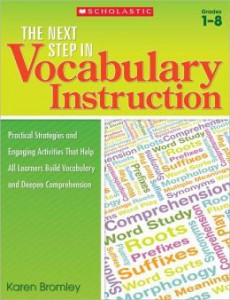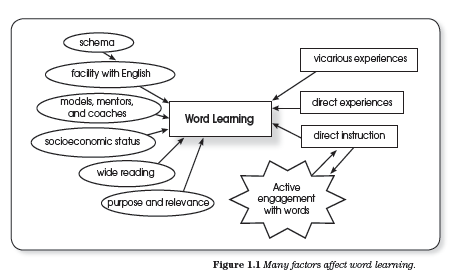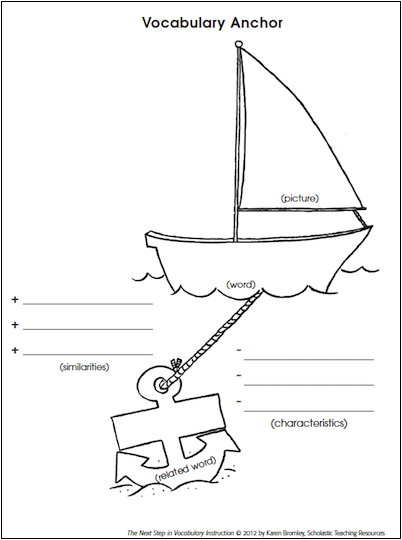Guess What? Learning Vocabulary Can Be Fun!
The Next Step in Vocabulary Instruction: Practical Strategies and Engaging Activities That Help All Learners Build Vocabulary and Deepen Instruction
By Karen Bromley
(Scholastic, 2012 – Learn more)

I don’t always read the dedication in a book. I try to get to the meat and potatoes of the text. However, something compelled me to read this page before venturing any further: “With special thanks to my students and the classroom teachers who contributed ideas to this book.”
Wow! I fell in love with The Next Step in Vocabulary Instruction: Practical Strategies and engaging Activities That Help All Learners Build Vocabulary and Deepen Instruction with this one sentence.

Beyond the worksheet and rote definitions
Teaching vocabulary is no longer a filler activity, where we hand out the study sheet or have students look up words in the dictionary. It’s not about being able to regurgitate the definition of a word on demand. Instead, the focus needs to be on understand the meaning of a word and how to apply it meaningful conversations.
“By some estimates, vocabulary comprises as much as 70-80 percent of comprehension” (Nagy & Scott, 2000). No wonder vocabulary is a foundation element of the Common Core State Standards. The Standards (Vocabulary Acquisition & Use) aim for students of ALL grade levels to “expand their vocabulary in the course of studying content” and be proficient at reading and understanding complex nonfiction texts. This is where Bromley becomes our invisible “guide by the side.”
Vocabulary is the basis of listening, speaking, reading, writing, viewing and thinking. Now think about the factors that influence word learning for students: Lack of schema or prior knowledge; socioeconomic status; students whose native language differs from English; models such as the type of books students are exposed to or the type of language they hear from parents and adults; and the purpose a student sees for learning language. (p. 7-9)
This is not a simple task for an educator. Couple that responsibility with “having to fit” vocabulary instruction between the other core and encore subjects such as technology and world languages! You begin to wonder where and how to start this daunting task. The answer is found in Bromley’s engaging and supportive resource.
The good news for teachers is that research proves vocabulary instruction does improve reading comprehension. (Stahl, 2005) However, as Bromley points out in her book, teaching vocabulary should not be an isolated instructional experience. Circling the correct definition of a word does not assure that a child understands how to apply the word in a sentence or conversation, or if they really understand what the word means.
The ‘why’ of vocabulary instruction
Bromley explains the “why of vocabulary instruction,” the role of vocabulary in comprehension and fluency, vocabulary building activities, and how to create independent word learners. The author, a former third grade teacher and K-8 reading specialist, is a trusted expert who is currently a Distinguished Teaching Professor at Binghamton University (SUNY) and a Board member of the International Reading Association.
Her 144-page book provides research in vocabulary instruction, sample lessons, vignettes, and children’s literature suggestions; technology based instructional activities; and interactive instructional approaches that can be used with any subject area and at any time. The approaches in this book are fun, exciting, transferable, and definitely NOT boring or rote. The author encourages teachers to actively engage students in the development of true word study.
Being a reflective learner is an important part of our role as educators. One of the “perks” in each chapter is the “Extend Your Thinking” sidebars that Bromley includes. She poses questions such as “How would you accommodate students who cannot fluently read the science or social studies texts you are expected to use at your grade level?” and “How could you help struggling elementary schoolchildren use alliteration, rhymes, and similes in their stories? What value do you see in this?”
I found myself pausing at these critical points and jotting down my responses in my teaching journal or talking with colleagues to hear their responses. Don’t you love books that really make you think?
Seeing meaning
According to research by Fountas and Pinnell (2001), “when content is illustrated with diagrams, the information can be maintained by students over a period of time. Organizers portray knowledge in a meaningful way which helps bring clarity to ideas as connections are made. Through these experiences, students develop a deeper understanding of the words.” Creating visual representations of words helps with understanding, particularly with ELL students.
Bromley effectively applies visual literacy through activities, games and graphic organizers to make learning more concrete. One of the activities included in the book is the Vocabulary Anchor that can be used to introduce a new term during whole group instruction. Using a chart or interactive whiteboard, the teacher facilitates a classroom discussion by introducing the new word with a similar term. For example, to teach the word neutron, you might anchor the word with a gearshift of a car, brainstorming the similarities, characteristics, and related words. (See graphic organizer below.)
I have to admit, I am partial to teaching students how to “study words” by looking at the word structure or morphology (study of how letters go together to represent meanings). I remembered a discussion my sons and I had when they were in college. Both boys felt the reason they performed extremely well on the SAT was due to the Latin class they took in high school. Their insights helped me understand that the roots of OUR language were Latin. Can you imagine…90 percent of English words with more than one syllable are Latin-based and most of the remaining 10 percent derive from Greek! (Rasinski, Padak, Newton& Newton, 2008)
I was delighted to learn that the Common Core State Standards (2011) suggest that beginning in second grade, students should recognize and be able to “use the most frequently occurring inflections and affixes as clues to the meaning of an unknown word” and in third grade they should be able to “use a known root word as a clue to the language of an unknown word with the same root”. I was equally delighted when I read Bromley’s chapter “Looking Closely at Word Structure.” Most of the activities are easily adaptable to all grades and many provide for the individual needs of a student. I have successfully used some of the activities in the book already and my students are begging to do more vocabulary “work.”
As I use Bromley’s book, I have felt that it isn’t vocabulary work anymore but vocabulary fun!
Linda Biondi is a fourth grade teacher at Pond Road Middle School in Robbinsville, NJ, and a long-time Morning Meeting practitioner. She’s also the recipient of several educational grants, a Teacher Consultant with the National Writing Project and a participant on the NJ Department of Education Teacher Advisory Panel. She recently attended the invitation-only ECET2 Conference in New Orleans to explore teacher leadership and collaboration.




































